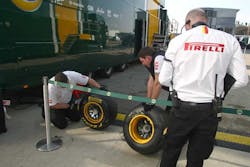The test takes place over a five-day period from March 8-12. However, the 12 Formula One teams will test for a maximum of four days each - bringing their total number of pre-season test days up to the 15 days that have been agreed.
With Pirelli recently announcing the P Zero tire compounds that will be taken to the first three races in Australia, Malaysia and China - the hard tire as the prime choice and the soft as the option - the teams will concentrate their testing work on those two compounds at the final test in Barcelona.
The Italian firm is bringing 35 sets of tires per team to the Spanish Grand Prix venue: a total of 1680 tires, including five sets of intermediate tires and three sets of wet tires per team. This is considerably more than the two sets of intermediate tires and three sets of wet tires that had been earmarked for Bahrain.
However, the teams will be hoping for warm conditions in Barcelona, unlike the previous test at the track, in order to more accurately replicate the conditions that they are likely to encounter over the course of the season.
Pirelli's Motorsport Director Paul Hembery said: "Our last test in Barcelona was held in temperatures of just six degrees in the mornings, which didn't help to rubber the track in or gather the information necessary to base strategies on over the course of the season. We're hoping for warmer weather this week, although it's unlikely to be as warm as the temperatures we are expecting for the first race in Australia. Having announced our compounds for the start of the year, most of the teams will concentrate on testing the hard and soft P Zero tires. We're expecting them to focus on long runs and race simulations, which should confirm the results we have previously extrapolated from our testing data: two or sometimes three pit stops at every race."
The hard P Zero compound offers a good balance between performance and durability, making it an ideal choice of prime tire over a long run in warm conditions. The soft P Zero compound takes less time to warm up and is quicker over a shorter period of time, but is also designed to work at its best in temperatures of more than 15 degrees centigrade: which are the ambient conditions for the vast majority of Formula One races.
A priority for the teams at this week's test will be to complete set-up work that optimizes the balance of the cars on the new P Zero rubber. The compounds are identical for both front and rear tires, but the rears – as is the case with all rear-wheel drive cars – warm up quicker because of the traction going through them. The front tires take longer to reach ideal temperature, provoking a change of balance, which the drivers and engineers must make the most of by adjusting the set-up.
Latest in Retail
Latest in Retail



